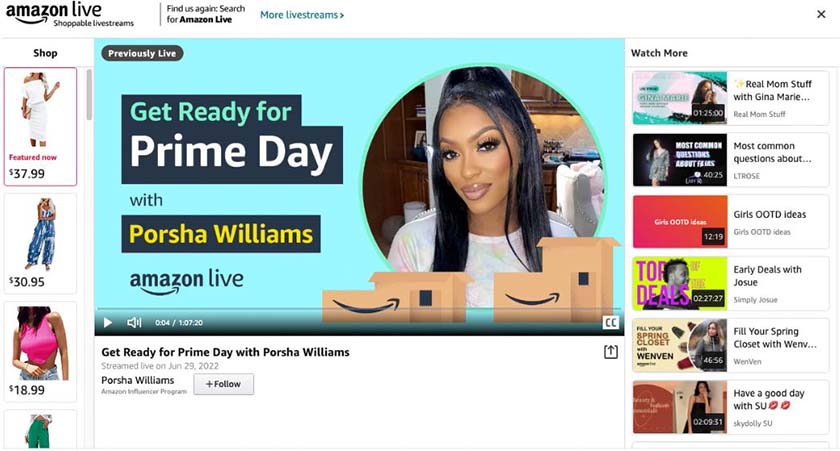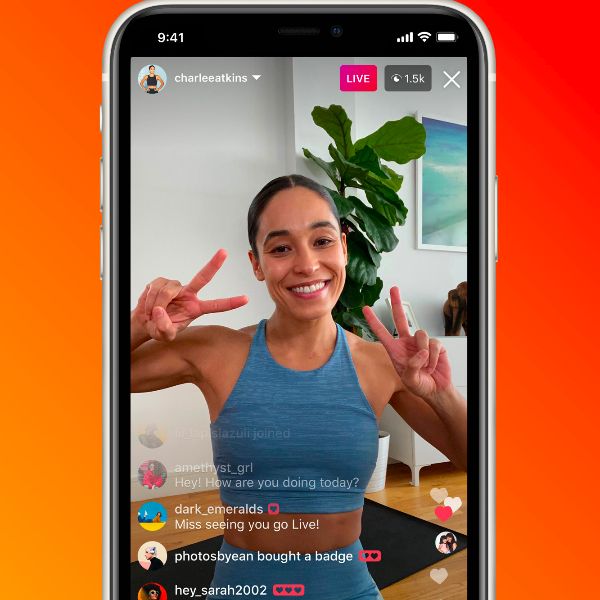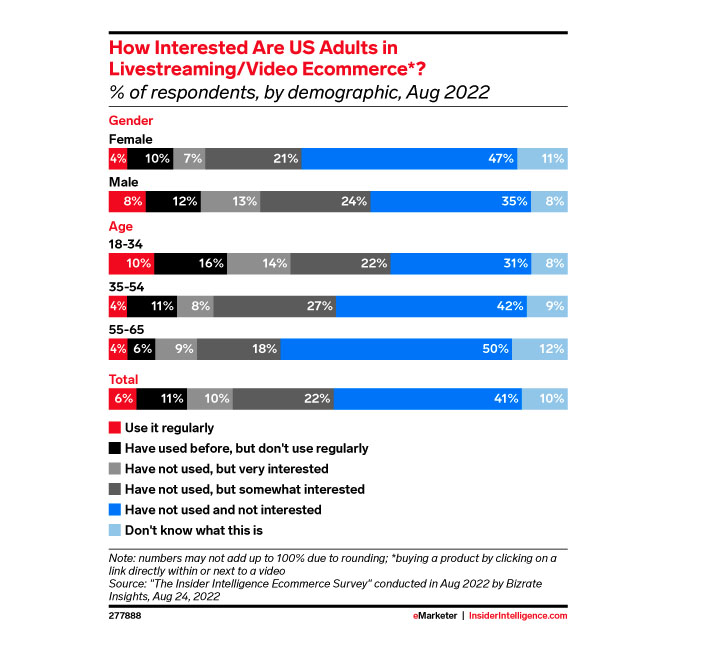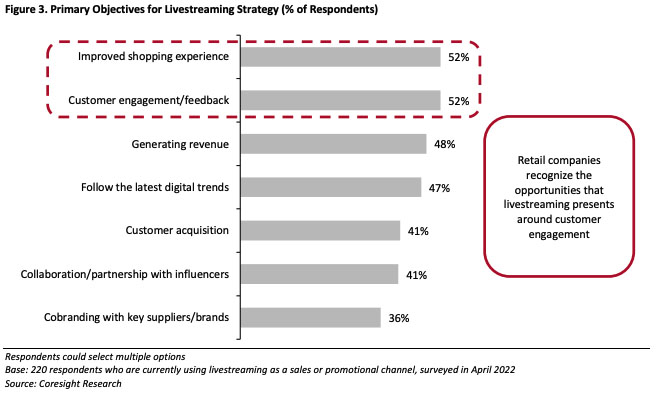Livestream shopping, also known as live shopping/live commerce, is a marketing technique in which businesses hold live shopping events online—frequently via Facebook, YouTube, or Instagram—to showcase and sell their products. Viewers can see the products in action, ask questions during the event (which is often hosted by a celebrity or influencer), and ultimately purchase items in real time.
Live streaming is a great marketing strategy to deepen your connection with customers, expand your reach via influencer partnerships, and potentially boost conversion rates.
This article will take a look at the most significant live shopping trends and statistics, so your business can take advantage of this growing and powerful selling channel.
Industry Trends
The livestream shopping industry is expanding into US markets at an impressive clip, boasting high conversion rates and a growing foothold in the fashion industry. But, whereas livestream shopping has been around a bit longer and has garnered more trust in Asian markets, American consumers are still a bit skeptical of the new medium.
1. The US livestream shopping market is estimated to be worth $68 billion by 2026
A key trends report from Coresight Research and Bambuser estimated the value of US livestream shopping to hit $32 billion by the end of 2023. That number will more than double to about $68 billion by 2026 and make up more than 5% of total ecommerce sales.
2. Livestream shopping app installation jumped 77% in the first half of 2022
The top 10 live shopping apps grew 77% year-over-year in the first five months of 2022, with some 2.3 million installs, according to data from Sensor Tower. Those apps include QVC, NTWRK, and Whatnot.
Did You Know? Between 2020 and 2022, livestream viewing minutes grew by 240%, according to Bambuser.
3. In the US, clothing is the top-purchased category for livestream shopping
While China boasts groceries as the most-purchased shopping category for livestream shopping, according to a McKinsey study from 2022, US consumers, along with Europe and Latin America, most often purchase clothing at live shopping events. 43% of livestream purchases fall into the clothing category for US consumers, followed by skin care at 32%, accessories at 31%, and body care at 31%.
Top 5 Categories Purchased via Live Commerce According to McKinsey & Company
% of live commerce users
China | US | ||
Groceries | 54% | Clothing | 43% |
Clothing | 45% | Skincare | 32% |
Footwear | 33% | Fashion accessories | 31% |
Skin care | 30% | Body care | 31% |
Hair care | 26% | Hair care | 30% |
Latin America | Europe | ||
Clothing | 48% | Clothing | 39% |
Electronic devices | 40% | Electronic devices | 29% |
Footwear | 36% | Hair care | 29% |
Fragrances | 30% | Fashion accessories | 28% |
Hair care | 29% | Beauty accessories | 27% |
4. Facebook is the most popular live shopping platform in the US
Facebook is the most popular livestream shopping platform among US retailers, with 55% of businesses using the platform in 2022.YouTube is right behind at 52%, with Instagram taking the third spot.
5. Instagram is the most frequently used platform to “go live”
While live commerce is most common on Facebook and YouTube, more content creators “go live” on Instagram than any other platform (62% compared to just 5% for Facebook). Consider meeting your consumers where they are already acclimated and partaking in live video.
6. Companies report live commerce conversion rates are up to 10x higher than conventional ecommerce
With the ecommerce retail market more saturated and competitive than ever, companies that use live commerce strategies are seeing conversion rates of up to 30%. That is 10 times higher than the average ecommerce conversion rate.
7. The average conversion rate for a livestream shopping event is 9%
While the conversion rate range for livestream shopping can go up to 70% for certain categories, on average, livestream shopping events see a conversion rate of about 9%. This is more than triple the conversion rate of your average ecommerce site, which hovers around 2.5% to 3%.
8. Livestream shopping has been a selling strategy in the luxury goods industry the longest
Luxury goods retailers have been livestreaming the longest. 30% of luxury retailers that use livestream shopping have been using the strategy for more than two years. That compares to about 20% or less for businesses in other markets (such as apparel, beauty, grocery, and electronics).
9. US consumers are much less familiar with shoppable live streaming than Chinese consumers
Although US livestream shopping is growing, consumers here are much less likely to participate in or even know about live shopping events than their Chinese counterparts. China is the world’s largest livestream shopping market, as evidenced by Coresight Research data showing that virtually all Chinese consumers have watched a livestream selling event. That dwarfs the US’s 32%. Furthermore, 43% of US consumers have never even heard of live shopping. So, there is a lot of room for growth—as well as education and exposure—in the US.
Retailer Insights
Retailers are placing a lot of hope in livestream shopping and see it as an important part of retail’s future landscape. From higher conversion rates to deeper customer insights and connections, there is a lot to be gained for retailers that engage in live commerce.
10. Live shopping is one of the top 8 digital commerce channels for retailers
According to WARC, livestream commerce has a purchase incidence rate of more than 30%. Although that’s significantly below online marketplaces and retailer websites (both at 70%-plus), it is now within six percentage points of social commerce.
11. Customer engagement and revenue are the top benefits of shoppable livestreaming
Although you might think revenue is the main driver for creating livestream events, livestream shopping statistics show that customer engagement is equally important for North American retailers. Each was called out as a primary benefit by 49% of survey respondents.
Get started boosting your customer engagement and driving sales with our guide to Customer Engagement Strategy Tips to Boost Sales.
12. 47% of livestreaming retailers expect livestream channel growth of between 10%–50%
Nearly half of retailers that participate in livestream events predict strong growth of 10%–50% over the next two years, with an additional 16% anticipating growth of greater than 50%. Retailers in the beauty, consumer electronics, and general merchandise categories are the most bullish.
13. Retailers use an average of nearly 4 platforms to livestream
According to Coresight Research and Bambuser, proprietary websites, social media, and video-sharing networks are among the 3.9 platforms retailers use for livestreaming. Consumers also use multiple platforms—2.5 on average—to view livestreams.
14. Nearly 30% of livestreaming retailers use their own platform
Retailers’ multi-platform approach to livestreaming, as illustrated by the statistic above, includes using their own website or app. Twenty-eight percent of retailers engaging in livestream events host them on their own platforms alongside more popular social media and video-sharing platforms.
15. Retailers believe educational content is key to influencing livestream viewers
A key livestream shopping trend you will see throughout these stats is the importance of education. Surveyed retailers said that providing product education during a livestream had the biggest impact on customer behaviors, followed by the livestream topic and offered incentives. Entertainment value was deemed the least impactful.
16. More than half of livestreaming retailers use marketing agencies for promotion
Coresight Research/Bambuser’s survey revealed that 54% of retailers that produce livestream events use a marketing agency for promotion. Another 50% cross-promote their events with other brands or retailers, and nearly half use content agencies to help produce the livestreams.
17. 46% of companies have used live data/customer tracking technology during live commerce events
Live data analysis/customer tracking is the top technology used in live shopping. Other frequently used technologies include screen sharing with the host and a virtual backdrop or green screen to enhance the viewing experience. Augmented reality/virtual reality and artificial intelligence (AI)-powered hosts also made the list.
18. Livestreaming events during Amazon Prime Day attracted more than 100 million views in 2022
Thousands of brands produced livestream events for Amazon Prime Day 2022. Overall, the events attracted more than 100 million views, with some 57,000 concurrent views at its peak.

Various celebrities and influencers participated in livestreams for Amazon Prime Day in 2022. (Source: TechCrunch)
19. Retailers that use livestreaming are investing 10%–50%+ of their marketing budget on the sales channel
Retail companies that have used livestream shopping in the past are devoting a significant portion of their marketing budget to grow their livestream shopping channel. According to a study from Coresight Research, Firework, and Retail Innovation, half of the companies that are currently using livestreaming reported that they are spending 10%–50% of their total annual marketing budget on livestreaming, and 28% are spending over 50% on the channel.
Want to learn more about retail marketing strategies and how they can boost your business? Check out our retail marketing guide.
Consumer Insights
So, what do consumers think of this new shopping method? Well, even if there is some skepticism and inertia to overcome to get them to start using it, the consumers that are engaging in livestreams are spending and enjoying the experience. Read more to learn more about how consumers feel about and use livestream shopping events.
20. Nearly a quarter of livestream viewers make a purchase during the live show
One of the key live shopping statistics to know is what actions customers take as a result of viewing a shoppable livestream. Coresight Research and Bambuser found that 23% of ecommerce livestream viewers bought products during the livestream. But what happens after a livestream event can be just as important—if not more so. Another 34% of viewers made a purchase after the livestream event, and 35% began following the brand or host on social media.
21. 6% of US consumers regularly make purchases at or after livestream shopping events
According to Insider Intelligence research, only 6% of US adults say they regularly purchase products from livestream events, while 17% have ever made a livestream purchase. Insider Intelligence thinks that TikTok will be the gateway for North American consumers to increase their trust and use of live shopping events.
Boost your brand’s social media presence so you can meet consumers wherever they like to shop. Get started with our guides on:
- How to Make a Social Media Plan.
- Selling on Facebook Shops & Facebook Marketplace
- How to Sell on Instagram
- How to Sell on TikTok
- How to Sell on Pinterest
22. Consumers under 45 are twice as likely to have purchased during a livestream than those over 45
According to The Influencer Marketing Agency, 44% of US consumers between 18 and 45 have made a purchase during a live shopping event. On the other hand, only 22% of consumers older than 45 have made such a purchase.
23. About half of US consumers have spent between $20 and $100 on livestream shopping in the past three months
Twenty-seven percent of respondents to The Influencer Marketing Agency’s late 2022 survey had spent between $20 and $50 during live commerce events over the previous three months, with another 24% spending between $50 and $100. Only about 10% of respondents said they had spent more than $200.
24. 17% of US consumers frequently watch influencer shopping livestream events
A study from Global Web Index found that 17% of consumers in the US frequently watch influencer livestream events, with 70% of them likely to buy products from influencers they follow. This represents a huge, engaged audience that already has a rapport with who they are watching. Taking advantage of this space will be increasingly important for retailers in 2023 and beyond.

Livestreaming is increasingly popular among audiences, especially influencer livestreams. (Source: The New York Times)
25. Concerns around social commerce and preference for in-store shopping are the main reasons consumers don’t consider live shopping
A Morning Consult survey found that about 55% of consumers who won’t consider livestream shopping cited both a preference for in-store shopping and a wariness about shopping via social media. Security and trust issues were recurring themes among the responses.
26. Finding a good deal is the top reason livestream viewers watch events
Nearly 40% of livestream viewers said they watch shoppable livestreams to find a good deal, followed by 34% who want to discover a new product and 31% who want to learn more about a product they are already aware of. Other reasons for watching these events include connecting with a favorite brand and watching something new.
27. Livestream viewers expect to see expert reviews and customer testimonials
Reinforcing the idea that education is a key component of a good livestream shopping experience, 47% of consumers who regularly view shoppable events expect to hear from industry experts and customers. Other things viewers expect to see include product hacks and insight into the manufacturing process.
28. More than 80% of Gen Zers watch livestreams before 5 p.m.
The younger the consumer, the more likely they are to watch shoppable livestreams earlier in the day. For example, 82% of those aged 18–25 watch before 5 p.m. On the other hand, older generations, such as Gen Xers, are much more likely to watch in the evening.
Learn more about how you can appeal to the newest generation of consumers with our guide to Gen Z consumer behaviors.
29. By a slim margin, consumers prefer livestream shopping events for just a few viewers
In Coresight Research/Bambuser’s survey, 31% of respondents said they preferred a one-to-few livestream format, just surpassing the 30% that favored one-to-many. One-to-one garnered 15% of the responses.
30. Three-fourths of livestream shoppers view an event at least a few times a month
Of regular livestream shopping viewers, about a third watch a few events per week. Nearly 30% watch a few times a month, and 18% watch daily.
31. American men use livestream shopping twice as much as women
Where only 4% of American women say that they use livestream shopping regularly, 8% of men admit to doing so. Additionally, men are more likely than women to be interested in learning more about livestream shopping, with 13% of men expressing interest compared to 7% of women.

32. Retailers cite engagement and customer experience as their primary objectives for livestream events
Retailers want to accomplish a lot in hosting livestream shopping events, from revenue to staying ahead of trends. Their top livestream objectives, however, are to improve the shopping experience for their customers (52%) and to boost their customer engagement (52%).

Frequently Asked Questions
Click through the questions below to get answers to some of your most frequently asked questions about livestream shopping trends and statistics.
Livestream shopping can boost conversion rates, improve customer engagement, enhance customer experience, and ensure that your business is staying on top of emerging retail trends.
You can sell anything on livestream shopping events – from cars to clothes. The product categories that perform the best on livestream events, however, are clothing, groceries, and beauty.
Livestreaming does not have to be expensive, but it can be, depending on how much you invest in your set, your host, marketing the event, and your livestream platform.
Bottom Line
Livestream selling is an up-and-coming sales channel for retailers. While still in its early stages in the US, we have already seen live commerce take rapid leaps in penetrating the retail market in China and several other countries. In the US, there are signs we will soon experience the same phenomenon. Whether you are opening a new retail business or running a well-established brand, understanding the livestream shopping statistics we’ve covered above can help you determine how to best take advantage of this growing opportunity.